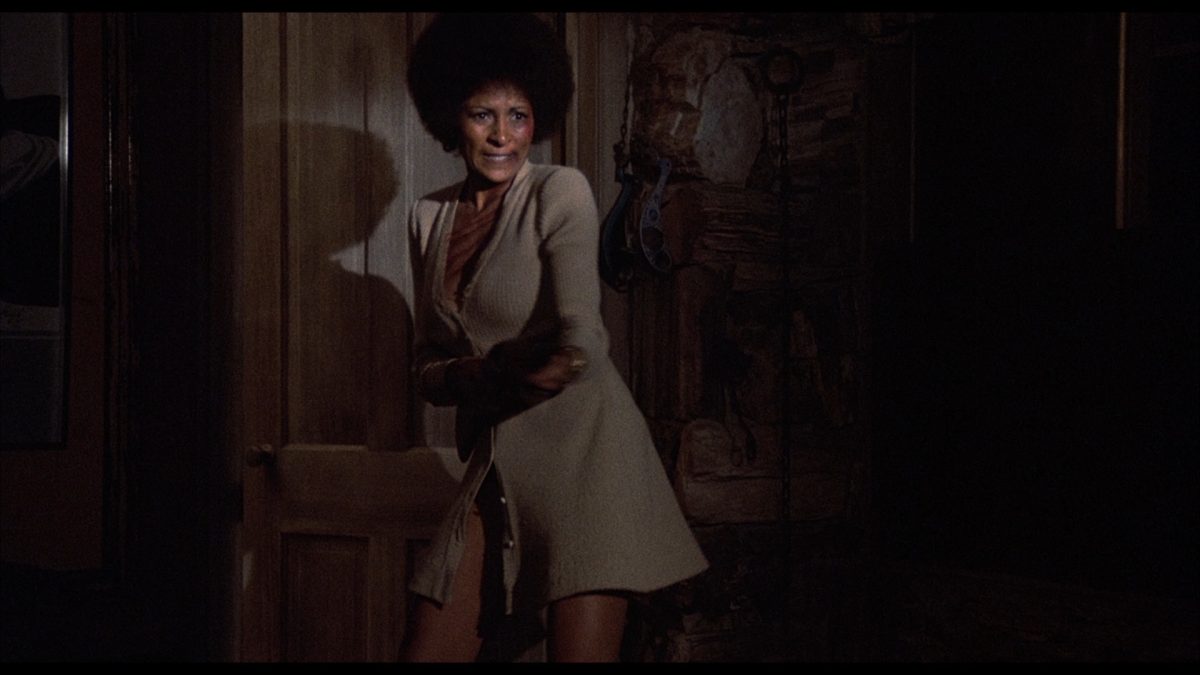
The following notes on Coffy were written by Sarah Mae Fleming, PhD student in the Department of Communication Arts at UW-Madison. Coffy screens at the Cinematheque on Friday, February 21 as part of our “Claudine, Coffy, and Cleo” series. Venue is located at 821 University Ave, 4070 Vilas Hall. Admission is free!
By Sarah Mae Fleming
“They call her Coffy, and she’ll cream you.” “The baddest one-hit chick-squad that ever hit town. She’s the Godmother of them all.” Of all the taglines associated with Coffy, Jack Hill’s 1973 star vehicle for Pam Grier, none of them capture the complexity of the film like the final lines: “It seems like I’m in a dream – and I’m still in this dream.” These lines serve as an answer to an earlier question posed by Coffy to her friend, police officer Carter (William Elliott), “Did you ever do something when you were mad? Really mad? And it was like living in a dream?” That dream is a world in which Coffy, a nurse by day and vigilante by night, uses her wits, her skills, and what Roger Ebert accurately referred to as her “astonishing form,” to brutally murder drug dealers in an act of revenge for her eleven-year-old sister whose life has been ruined by heroin use.
Often credited as the first Black woman-centered action movie, Coffy lifted Grier into Blaxploitation fame alongside Shaft’s Richard Roundtree in 1971and Superfly’s Ron O’Neal in 1972. Released by American International Pictures, the film surely aligns with AIP President and executive producer of Coffy Samuel Z. Arkoff’s “ARKOFF” formula: Action, Revolution, Killing, Oratory, Fantasy, and Fornication–featuring no shortage of sex and violence. But despite Coffy’s unmatched talent at both seduction and destruction of her enemies, she insists on asking herself, and the audience, what all this violence amounts to.
Still, the sex and violence are important. AIP’s pressbook for Coffy (viewable thanks to the WCFTR’s Media History Digital Library) offers several wonderful ideas to promote the film with an emphasis on its adult themes. Some suggestions include an original cocktail (a “Coffy” Royal), or to schedule a late-night showing of the film with promotional language like “Stay up late with Coffy,” and “Nobody sleeps when they mess with Coffy.” Going even further, AIP recommends that theaters could display a 12-gauge double barrel shotgun painted pink with added lace, and write “hers” on the butt. More flamboyant even, the pressbook proposes that the theater may want to litter the lobby with dummies with “judicious use” of red paint to simulate the wreckage Coffy leaves behind.
Indeed, while Coffy meditates on complicated questions of race, power, money, and violence, the movie is also a lot of fun. In a sprawling 2020 interview with The New Yorker that covers topics like Grier being kicked out of the Troubadour with John Lennon and a story about Richard Pryor and a miniature horse, Grier herself refers to Coffy as “tongue-in-cheek,” asserting that “You had to have fun. You cannot be that dramatic in a culture that needs laughter.” One memorable scene that combines a very large salad bowl and razor blades hidden in a wig speaks to the interplay between brutality and absurdity that runs through the narrative.
This interplay was well-suited for Grier on her third collaboration with Hill. Grier and Hill previously worked together on the women-in-prison films The Big Doll House (1971) and The Big Bird Cage (1972), but neither film serves as such a stunning showcase of Grier’s abilities as Coffy or the spiritual sequel and fourth Grier and Hill collaboration, Foxy Brown (originally titled Burn Coffy Burn). When asked if a Blaxploitation movie was something Hill imagined making, he responded “AIP was looking for somebody to do a picture. It turned out to be a ‘Black’ film and my heart kind of sank because I didn’t feel that this was a genre I knew how to deal with. But when Larry [Gordon] said it was to be a Black woman, I thought that it was the opportunity to do something really, really good with Pam Grier.” That line between Grier and Coffy can feel like a blurry one. Hill wrote the script for Grier, even if he couldn’t guarantee that she would play the lead, and he explains that Grier had many vital suggestions for Coffy’s character. Grier’s own clothes constituted much of Coffy’s costumes: her afro wig, her blouses, and her jeans.
The production of Coffy, which lasted a spare 18 days, just narrowly beat another Blaxploitation hit in a release date race. Jack Starrett’s Cleopatra Jones (1973) starring Tamara Dobson (which Cinematheque viewers can see in 35mm on February 28!) is another entry in the 1970s Black women-led exploitation pictures. Coffy and Cleopatra Jones have their differences, but they are both films that invert the action-movie formula to showcase a woman who possesses destructive and redemptive powers historically saved for men. When speaking about her roles as both Coffy and Foxy Brown, Grier lamented, “When I walked in a man’s shoes, now I’m exploiting women? No one fights for us. She has to fight for herself.”
And fight she does. But what is distinct about Coffy is the heroine’s insistence on questioning the value of this endless fighting. Black identity and violence had been intertwining on screen with growing intensity, seen in early 1970s films like Melvin Van Peebles’ 1971 Sweet Sweetback’s Baadasssss Song, Gordon Parks’ Shaft, Gordon Parks Jr.’s Superfly, and Eddie Romero’s 1973 Black Mama White Mama. Unlike her male protagonist counterparts, Coffy grapples with her complicity in the violence that grounds the film, and by extension the entire genre. While other Blaxploitation heroes embraced their violent personas without question, Coffy’s power lies not just in her ability to hide weapons in her hair, but in her willingness to question the very dream of vengeance she’s living.